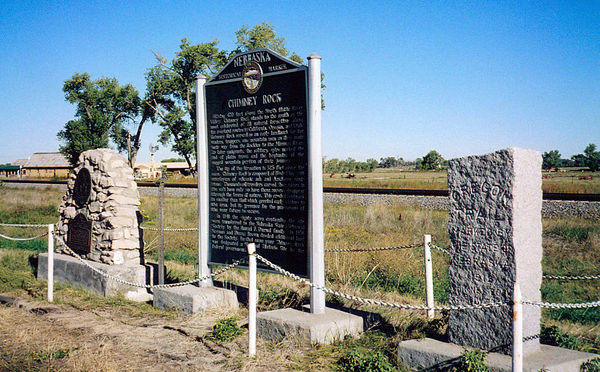Marker Text
Rising 470 feet above the North Platte River Valley, Chimney Rock stands to the south as the most celebrated of all natural formations along the overland routes to California, Oregon, and Utah. Chimney Rock served as an early landmark for fur traders, trappers, and mountain men as they made their way from the Rockies to the Missouri River. To later emigrants, the solitary spire marked the end of plains travel and the beginning of the rugged mountain portion of their journey. The tip of the formation is 325 feet above the base. Chimney Rock is composed of Brule Clay with interlayers of volcanic ash and Arickaree sandstone. Thousands of travelers carved their names in the soft base only to have these records disappear through the forces of nature. This eroded landmark is smaller than that which greeted early visitors to the area, but its presence for the generations of the near future is secure. In 1941 the eighty acres containing the site were transferred to the Nebraska State Historical Society by the Roszel F. Durnal family. In 1956 Norman and Donna Brown deeded additional land to the Society. In that same year, Chimney Rock was designated a National Historic Site by the federal government.
Further Information
The most famous landmark on the Platte River Road was Chimney Rock, a geological feature in the Wildcat Hills of west Nebraska. Studies by historians have shown that between 95 and 97 percent of all the westward migrants who kept journals of their travels made some mention of Chimney Rock, thus making it the most talked about feature along the road. The popularity of the feature was so great one traveler wrote, “This curiosity has been well described. I will not inflict another upon the reader.” It is estimated that the tip of Chimney Rock is 325 feet above the base. The spire alone is estimated to be 120 feet tall. Based on descriptions by pioneers, it is believed that the rock could have been up to 100 feet taller during the mid 1800s than it is now. Erosion and lightning strikes are responsible for the drop in height. Many travelers in the Nineteenth Century predicted that the rock would soon erode away completely and become nothing more than a mound of rock and sand, but the monument is still present today. The rock was originally called “Elk Penis” by Native Americans, which was censored to “Elk Peak” by white travelers. The rock was usually called “the Chimney” in earlier accounts. The first known usage of “Chimney Rock” was in 1842 in the journals of Charles Preuss, the cartographer of John C. Fremont’s famous exploratory journey. Like many other landmarks on the trail, pioneers carved their names into its side. These names have all since eroded away. The Nebraska State Historical Society owns the oldest known photograph of Chimney Rock, taken by Charles R. Savage in 1866.
Bibliography / Read on: Mattes, Merrill J. The Great Platte River Road: The Covered Wagon Mainline via Fort Kearny To Fort Laramie. Lincoln: Nebraska State Historical Society, 1969.
Location
Nebraska 92 Scenic, Bayard, Morrill County, Nebraska; 41.720471, -103.3390





